Stargazing in Maine
With its rocky coastline, rolling mountains, and sprawling forests, Maine is an ideal spot for those who love to gaze up at the stars and explore the night sky.
Stargazing is one of those hobbies that can truly be enjoyed anywhere, but Maine is an especially great place for stargazing. With the sparse population and low levels of light pollution, you can experience some of the clearest night skies in the country.
The state’s vast expanse of darkness provides an excellent view of the Milky Way, shooting stars, and other celestial phenomena, making it a great place to set up a telescope or just take in the night sky with the naked eye.
With its diverse landscape, Maine is truly a stargazer’s paradise and you’re sure to find plenty of spots with beautiful views that can be enjoyed under the stars.
Whether you are local to Maine or just visiting, you’ll want to make sure you are prepared before embarking on your stargazing adventure. In this article, we’ll provide tips on the best locations and times to go, what gear you should bring with you, and a plethora of information that can help you make the most of your experience.
But first, let’s see what makes Maine a good place for stargazing.
8 Reasons why Maine is a good place for stargazing
- It has 32 state parks
- It has 4 national parks
- The average bottle scale rating in remote areas is around 2 to 3.
- On average, there are 129 rainy days and 236 sunny days.
- There are 5 astronomy societies to join.
- There is a monthly star party and two others that take place once a year.
- The low population density results in a lower overall light pollution level and cleaner air.
- Numerous outreach programs are held throughout the state to promote stargazing and the preservation of Maine’s dark skies.
The best places to stargaze in Maine
#1 Acadia National Park
Perhaps the most famous spot for stargazing in all of Maine is Acadia National Park. Its star-filled night skies provide a spectacular backdrop for those seeking a unique stargazing experience. Its remote location makes it an ideal spot to observe the wonder of the cosmos. As one of the few places in the country that is free from light pollution, Acadia National Park provides a perfect platform for appreciating the stunning beauty of the night sky.
Continuous work has gone into the preservation of the park’s night sky. For example, park lights are equipped with timers or motion sensors to ensure they are only turned on when needed.
- Website: https://www.nps.gov/acad/index.htm
- Bortle Scale Rating: Class 3
- Get Directions
- How far is it: 170 miles from Portland | 150 miles from Lewiston | 43 miles from Bangor
- Opening Times: The park is open 24 hours.
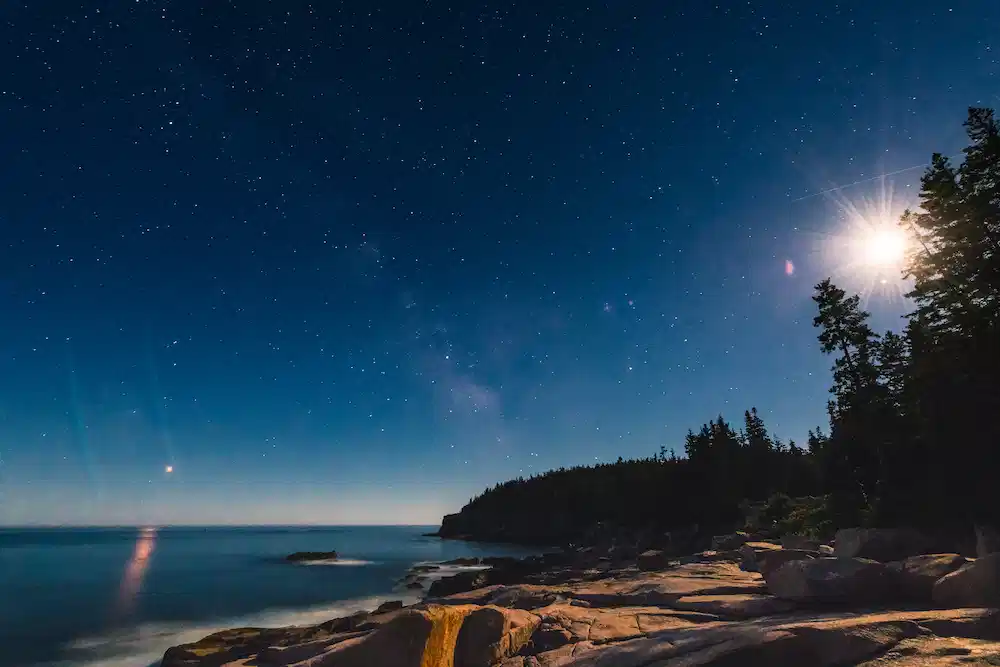
Courtesy of Eric Kilby
#2 Aroostook State Park
Aroostook State Park is a 5,200-acre park located near Presque Isle, Maine. It is the largest state park in the state and is a popular destination for camping, hiking, fishing, and other outdoor activities. The park features a large lake (Echo Lake), and a variety of hiking trails. There are also picnic areas, playgrounds, cabins, and other amenities.
The area is rather breathtaking both during the day and the night. Whilst the park closes rather early – it opens at 8 am and closes at sunset – visitors have the opportunity to watch the sun dip below the horizon and the stars come out. For stargazers the wishes to stay late, you may need to find a spot outside of the park boundaries.
- Website: https://visitmaine.com/
- Bortle Scale Rating: Class 3
- Get Directions
- How far is it: 284 miles from Portland | 262 miles from Lewiston | 156 miles from Bangor
- Opening Times: 9 am – 8 pm
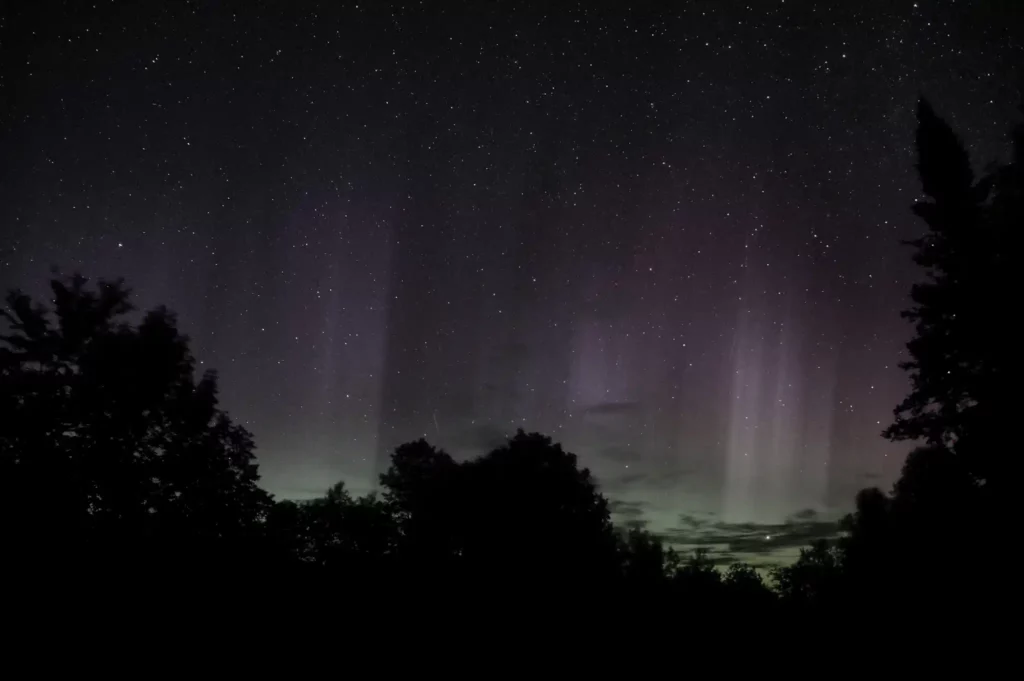
Courtesy of Mike Lewinski
#3 Baxter State Park
The park’s rugged terrain and vast wilderness make it a perfect spot for stargazing, with plenty of clear, open spaces for setting up a telescope or simply lying on a blanket and taking in the beauty of the star-filled sky. Additionally, the area is home to a variety of programs and events focused on stargazing held at the nearby Katahdin Woods and Waters, making it a great destination for anyone interested in exploring the night sky.
- Website: https://baxterstatepark.org/
- Bortle Scale Rating: Class 2
- Get Directions
- How far is it: 103 miles from Portland | 80 miles from Lewiston | 35 miles from Bangor
- Opening Times: 6 am to 10 pm
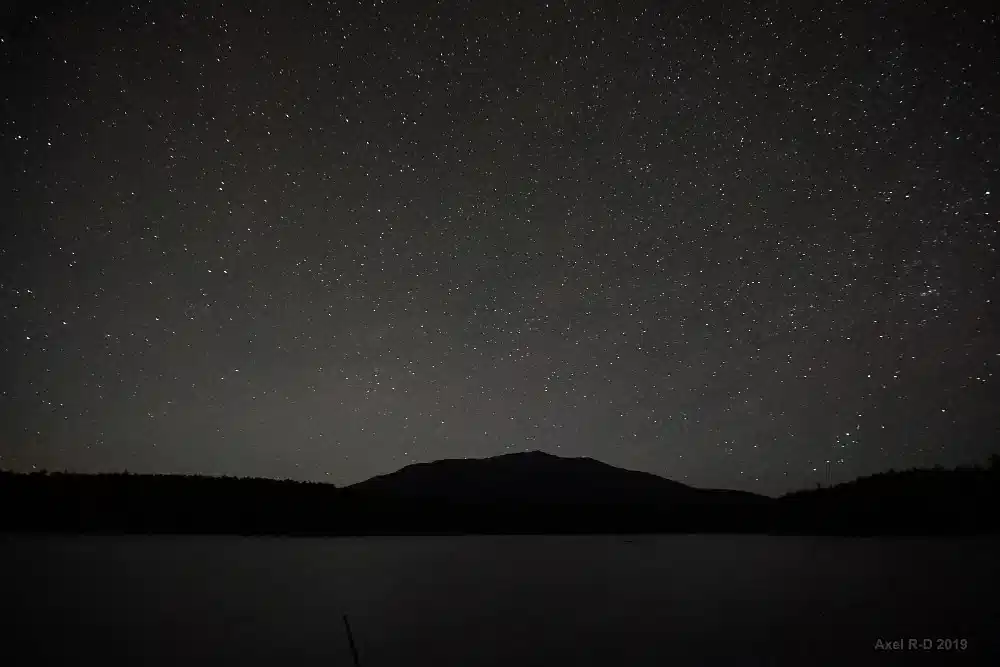
Courtesy of Axel Drainville
#4 Camden Hills State Park
Located in Camden, Maine, this state park offers panoramic views of the night sky and is a designated International Dark Sky Park. The park features several hiking trails and campsites, making it a great spot for stargazing. Additionally, you can take part in the regular stargazing tour operated by North Star Adventures. You can find more information here.
- Website: https://www.maine.gov/
- Bortle Scale Rating: Class 3
- Get Directions
- How far is it: 84 miles from Portland | 71 miles from Lewiston | 52 miles from Bangor
- Opening Times: 7 am – 11 pm
What's in the night sky this month?
Knowing what will be visible in the night sky in advance is important because it allows you to plan ahead and prepare for the upcoming nights. Planning is key when it comes to stargazing, so to help all of Maine’s stargazers, below is a quick summary of what’s in the night sky this month.
I hope this will help you get the best views possible and not miss any of the amazing heavenly sights.
A brief summary of astronomy events for December
- December 8th – Full Moon
- December 8th – Mars at Opposition (it will be at its brightest in the night sky)
- December 13th/14th – Geminids Meteor Shower – up to 120/hour at peak
- December 21st – Winter Solstice
- December 21st – Mercury at greatest Eastern elongation – 20.1° from the Sun
- December 21st/22nd – Ursids Meteor shower – only about 5-10/hour
- December 23rd – New Moon
Weather Forecast for tonight
Before you go planet hunting, it’s important to check the weather forecast for the night you plan to go out. Make sure there is little to no cloud cover, as it will make it very difficult to see anything.
The interactive chart below gives you a quick overview of the weather forecast in Maine for tonight and the next 6 days. Plan your stargazing session accordingly!
Light pollution in Maine
Light pollution in Maine is relatively low, so you should be able to find dark skies almost anywhere. Maine is known for its remote and rural locations, and as you can see on the map below, there are quite a few parks, wildlife refuges, and other public lands that offer excellent stargazing opportunities.
As long as you avoid built-up areas, you should be able to find some dark skies with a low Bortle scale rating. The below map shows you the light pollution levels across the entire state, the darker areas (low bottle scale rating) indicate the areas with the best conditions for stargazing.
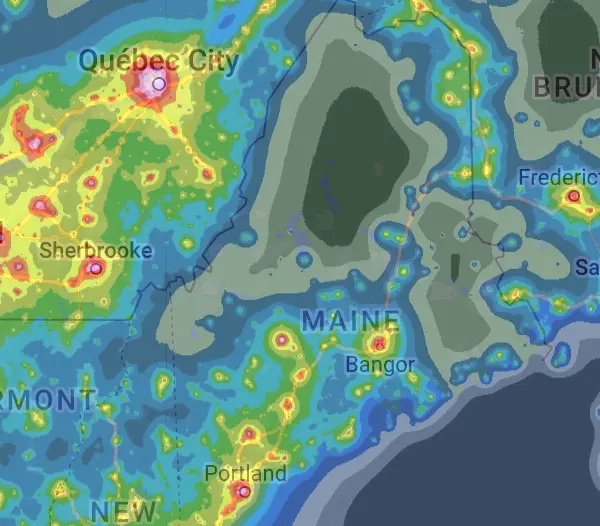
The above light pollution map for the state of Maine is a real testament of how good of a place it is for stargazers.
Moongazing in Maine
Maine is a great place to watch the Moon, thanks to its many dark sky sites. And at certain times of the year, you can even catch one of its eclipses. Maine has quite a few spots with excellent views of the sky, so you don’t have to go too far to find a great spot for moongazing. If you look at the widget below, you can see the lunar phase today. Alternatively, you can use my Moon phase calculator to find past and future moon phases.
Contrary to popular belief, the full Moon is not necessarily the best time to observe the Moon, as its brightness can be too intense when viewed through a telescope or binoculars. The waxing and waning phases of the Moon are generally better for moongazing because the details of its craters become more visible and the sunlight gives them a beautiful 3D effect.
Lastly, if you are planning to observe fainter objects like galaxies or nebulae, be sure to choose moonless nights for the best results.
This is because the Moon is very reflective and produces quite a lot of light pollution when it is half full to full. This will hinder your ability to see deep sky objects well.
Winter stargazing in Maine (December, January, February)
Winter is a beautiful time to go stargazing in Maine. The crisp, cold winter air produces a stunning night sky, with stars that appear brighter and colors that are more vibrant than during other seasons. Furthermore, the long winter nights provide ample time to observe the night sky before dawn and after sunset. Some of the most notable celestial objects to see in the winter sky include:
- The Orion Nebulae
- The Pleiades star cluster
- The Andromeda Galaxy
- Ursa Major and Ursa Minor (the Big Dipper and Little Dipper)
- Geminids, Ursids, Quandratids meteor showers.
However, it is important to note that the average temperature in Maine during the winter months (December to March) is around 0°F (-18°C), so be sure to bundle up!
Spring stargazing in Maine (March, April, May)
The spring months in Maine offer better weather for stargazing. For many astronomers around the world, springtime is known as “Galaxy season”. During this time of year, you’ll be able to see galaxies like Andromeda and the Triangulum Galaxy in stunning detail. Some of the most notable celestial targets in the spring night sky include the following gems:
- NGC 3628 The Hamburger Galaxy
- M64 The Black Eye Galaxy
- Mizar star
- Bode’s Galaxy
- Cigar Galaxy
- Beehive Cluster (Messier 44)
- Lyrids, Eta Equariids meteor showers
The average temperature during the spring season (April through June) is around 45°F (7°C). While still chilly, this is much more comfortable than winter temperatures.
Summer stargazing in Maine (June, July, August)
Summer is a great time for stargazing in Maine. The warm nights, combined with the long days, make it easier to stay up late and enjoy the night sky. Some of the most notable celestial targets in the summer night sky include the following gems:
- The Summer Triangle asterism
- Hercules and Sagittarius constellations
- Albireo
- Dumbbell Nebula (Messier 27)
- Eagle Nebula (Messier 16)
- Hercules Cluster (Messier 13)
- The Milky Way
- Delta Aquariids, Alpha Capricornids, and Perseids meteor showers.
The average temperature during the summer season (July through September) is around 68°F (20°C). Maine is renowned for having mild summers however it might feel cooler late at night, so make to bring a light jacket if you’re gonna be out most of the night.
Fall stargazing in Maine (September, October, November)
The nights become longer in autumn, allowing for darker skies and better visibility for stargazing. Additionally, temperatures tend to be cooler than on summer days, making it more comfortable to stay outside for long stretches of time (and less of those pesky flying bugs!). Finally, the air is often more clear and stable in the autumn months, providing excellent seeing conditions.
Some of the most notable celestial targets in the fall night sky include the following gems:
- Aquarius constellation
- The Andromeda galaxy
- Algol & Almach
- Globular cluster Messier 15
- Triangulum Galaxy (Messier 33)
- Mu Cephei & VV Cephei (one of the largest known stars)
- Draconids, Orionids, Taurids, and Leonids meteor showers.
When is the next meteor shower happening?
Meteor showers are one of the most impressive stargazing events of the year. Maine’s night skies are clear, dark and full of stars, making it the perfect location to view these incredible light shows in the sky. Every year, Maine is treated to an amazing display of shooting stars during the peak of the Perseid meteor shower in August.
With minimal light pollution, you can see hundreds of meteors streaking across the sky in a single night, making for a breathtaking and unforgettable experience. Below is the complete list of every meteor shower that can be seen every year.
- Quadrantids: January 3-4
- Lyrids: April 22-23
- Eta Aquarids: May 6
- Delta Aquariids: July 30
- Alpha Capricornids: July 30
- Perseids: August 12-13
- Draconids: October 8 – 9
- Orionids: October 21 – 22
- Taurids: November 12 – 13
- Leonids: November 17-18
- Geminids: December 14-15
- Ursids: December 22-23
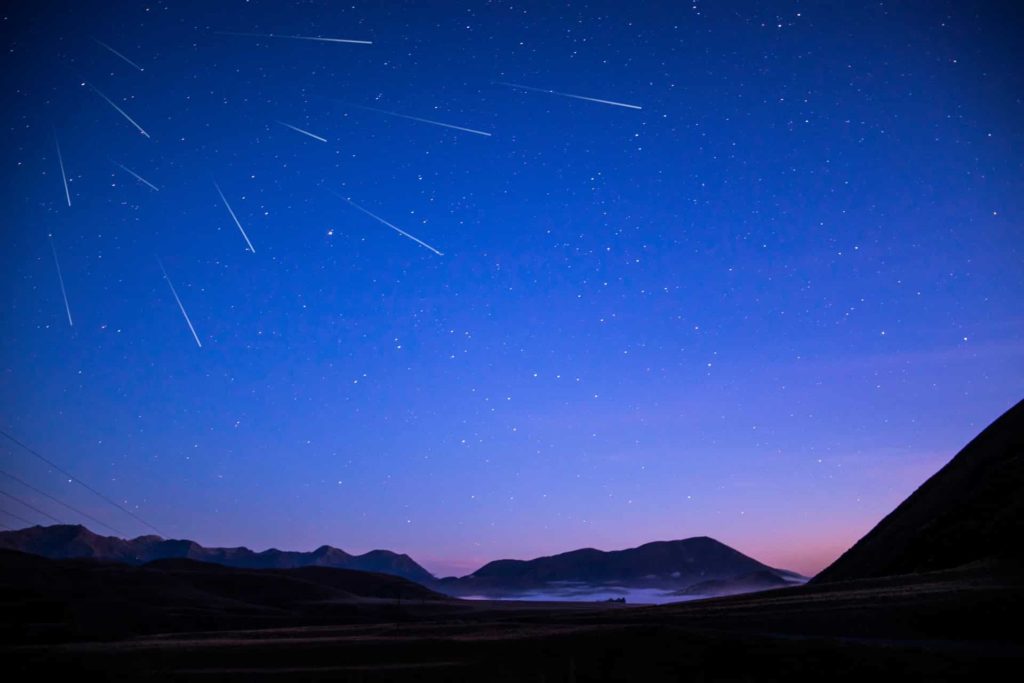
Astronomy Clubs & Societies in Maine
If you are planning on stargazing in Maine and need advice or have questions, joining a local astronomy club is a great way to learn more about the night sky and meet like-minded individuals.
They often organize star parties where you can try out different telescopes and binoculars, learn from experts, and share great stories.
There are 5 astronomy societies in Maine, including the following:
Astronomical Society of Northern New England
- City: Kennebunk
- Website: http://www.asnne.org/
- Email: asnne.astronomy@gmail.com
- Get Directions
Astronomical Society of Northern New England
- City: Whitefield
- Website: https://maineastro.com/
- Email: maineastro@gmail.com
- Get Directions
Downeast Amateur Astronomers
- City: Pembroke
- Website: none
- Email: csawyer7@roadrunner.com
- Address: Charlie Sawyer PO Box K Pembroke ME 04666
Penobscot Valley Star Gazers
- City: Stockton Springs
- Website: http://www.gazers.org/
- Email: pvsgpresident@gazers.org
- Directions: They do not have a physical place yet, their meetings take place on Zoom.
Southern Maine Astronomers
- City: Stockton Springs
- Website: https://www.southernmaineastronomers.org/
- Email: none, contact form on the website
- Directions: no physical address yet.
General Stargazing Tips
- Plan ahead: Choose a few specific objects you’d like to observe and research where to find them in the night sky. Download a stargazing app or print out star maps to use as a reference.
- Wait for darkness: Stargazing is best done when it’s completely dark outside, so aim for a time at least an hour after sunset. This will allow you to see more of the stars and planets in the sky.
- Find a good spot: Look for an area with little light pollution and a clear view of the horizon. Avoid areas with tall buildings or trees that could obstruct your view.
- Make sure to know the rules for public areas as you may need a permit, to purchase a campsite, etc. Think about who is coming and what you may need/ want such as bathroom access, electricity, distance from the car, etc.
- Be sure to check the moon phase for that day before you go: A bright full moon can wash out fainter stars and planets and make your night of stargazing difficult.
- Always plan backup dates: We cannot control or completely predict the weather. It’s one of the frustrating realities of stargazing: cancellations due to weather are common.
- Set up your equipment: If you’re using a telescope, set it up and let it adjust to the outside temperature for at least 30 minutes.
- Make sure your tripod is as steady as possible. Even the slightest wobble can cause stars to appear blurred.
- Bring eyepieces of various focal lengths: Different objects in the night sky are best viewed at different magnifications, so bring a variety of eyepieces for your telescope.
- Dress warmly: Stargazing can be a cold activity, especially in the winter, so be sure to dress in layers and bring a blanket or warm coat to keep yourself comfortable.
- Most importantly, enjoy! Let your eyes soak in the beauty of our night sky!
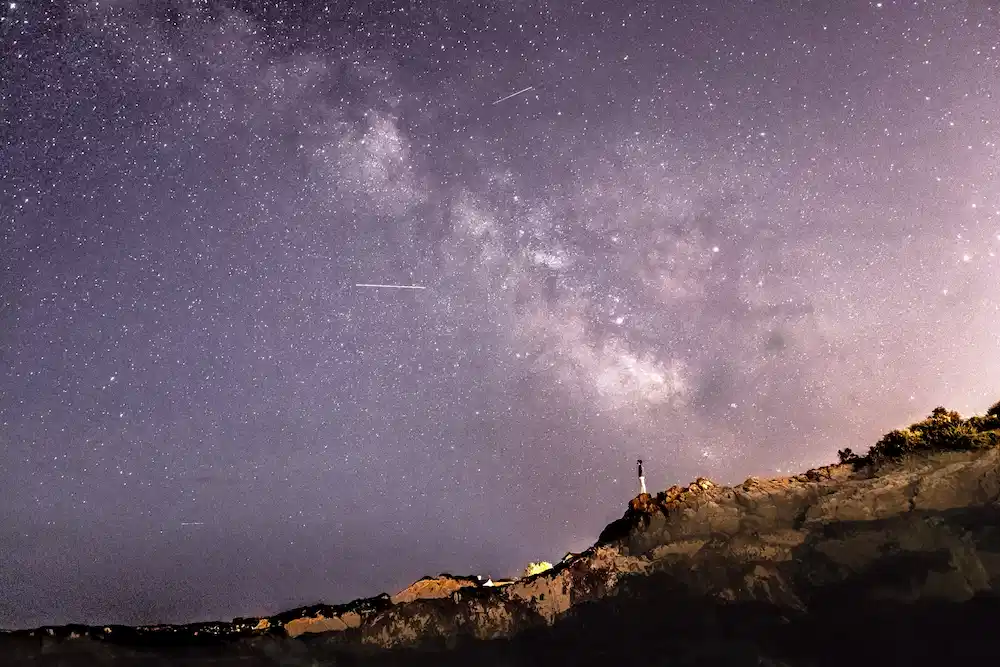
What to bring with you
- A few extra layers than you think will need (coats, blankets, etc.)
- Food and drinks to stay hydrated, caffeinated, and fed. Keep them away from any equipment (telescopes, etc.) though.
- Lighting: Flashlights or headlamps are recommended for setting up and taking down equipment, etc. and red lights will not ruin your night vision.
- Materials (star maps, night sky scavenger hunts, apps, etc.) for reference and fun.
- A comfortable foldable chair: Stargazing can be a long activity, so make sure you have a comfortable place to sit down.
- Bug spray: during the warmer months, bugs can be a nuisance. Bring along some insect repellant to keep them at bay.
- A green laser pointer: A green laser pointer can be a fun and useful tool for pointing out objects in the night sky.
- Extra batteries: If you’re using a motorized telescope or other electronic equipment, be sure to bring extra batteries in case they run out.
- A camera: you may be able to capture some beautiful photos of the night sky. Just be sure to bring a tripod to keep your camera steady during long exposure shots.
- Hand warmers: hand warmers are a godsend and a welcome addition to your stargazing kit. They can help keep your hands warm while you’re using your telescope or binoculars.
Safety tips when stargazing in nature
I have been stargazing for more than a decade and I understand that the night sky can be inviting and mysterious, but please take safety precautions when spending long hours in the dark. I have enjoyed stargazing sessions from my own backyard as well as remote and dark places.
Therefore, I have a few tips to keep in mind:
- Bring a buddy/group: Even if you’re an experienced stargazer, it’s never a bad idea to bring someone with you. It can help make the night more enjoyable and also provide safety in case something unexpected happens.
- Dress appropriately: Wear comfortable clothing that will keep you warm in lower temperatures (especially during winter months) but also be aware of bugs or other critters that can be attracted to light sources.
- Let someone know where you’ll be going: Give a family member, friend or roommate a general idea of where you’re going and when you’ll be back. What I usually do is share my live GPS location with my family so they know where I am and when I’m on the way home.
- Have the necessary supplies: Bring plenty of water, snacks and torchlights to create a comfortable environment for stargazing. Also, make sure to bring a first-aid kit in case of any emergencies.
- Be aware of your surroundings: make sure to stay away from any potential dangers such as cliffs, water bodies or cacti. Keep in mind that Maine is home to the largest population of black bears in the United States. Rattlesnakes, copperheads and mosses are also present in the state.
- Stay on established trails or roads: Avoid wandering off into the wilderness and bring a whistle and flashing lights so you can be found if you get lost.
- Being out in the dark can be disorienting, whilst also being a time when nocturnal animals become active. Make sure you know where you are and have an escape plan should something go wrong.
- Lastly, remember that you are in nature so always leave the place better than how you found it. Stargazing in Maine is an incredible experience and can be enjoyed by all! With proper preparation and safety tips in mind, stargazers of any skill level can enjoy a star-filled night under the Maine sky. Happy Stargazing!
Be sure to check out my guide, if you want to know more about safe stargazing practices.
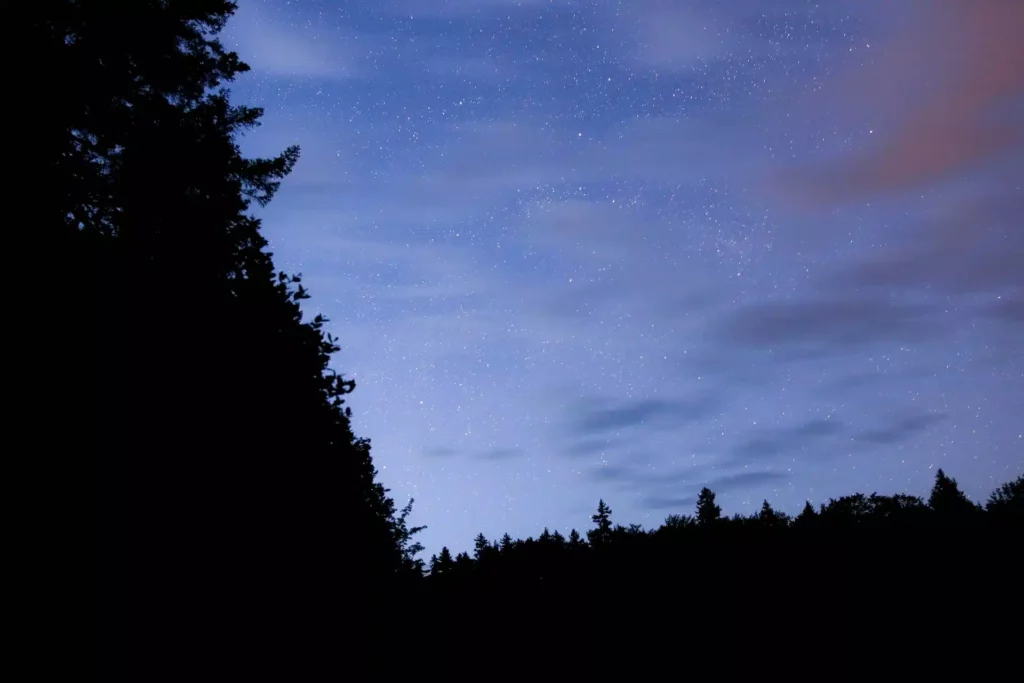
Consider going to a star party
As much as stargazing is often an individual hobby, it can also be a great group activity. A star party is a great way to learn more and connect with others who are interested in stargazing. You will likely be able to see a variety of viewing equipment and learn more about the night sky.
Star parties are usually held in remote areas where light pollution is scarce, but it’s always best to confirm with the organizers ahead of time if you have any questions. I have made countless new friends at these and I’m sure you will too.
Some of the star parties in Maine include:
Stars Over Schoodic
Regular guided tours of the night sky are held at Wright Hall at Schoodic Institute in Winter Harbor, Maine. During the tour, you’ll get to learn about the stars, constellations and galaxies visible in Maine’s night sky. The tours are tailored for people of all ages and skill levels.
- More information: https://www.schoodicinstitute.org/stars-over-schoodic/
- Get Directions
Maine State Star Party
The Maine State Star Party is a yearly event organized by the Downeast Amateur Astronomers (DAA) club. The event is held at the Cobscook Bay State Park every summer. This star party is rather popular and attracts many people from all around the state.
- More information: https://nightsky.jpl.nasa.gov/event-list.cfm?Club_ID=1465
- Get Directions
SMA Monthly Star Party
The Southern Maine Astronomers organize a star party every month in Brunswick. These public star parties are part of the ongoing collaboration between the club and the Maine Coast Heritage Trust. If you are a local or a visitor, you are invited to join in on the fun!
- More information: https://nightsky.jpl.nasa.gov/event-list.cfm?Club_ID=1474
Stars Over Katahdin
The Stars Over Katahdin star party is held annually at Taylor’s Katahdin View Camps & Campground for almost ten years in a row. This event brings together amateur astronomers from all around the region who come to observe and discuss the night sky.
- More information: https://www.friendsofkww.org/stars/
- Get Directions

Stargazing tours in Maine
Stargazing tours are usually organized by companies operated by star-loving locals who are experts in the field and can provide great insights about the night sky. There is usually a fee to pay in order to participate in these tours but they are worth the price considering the information and activities you will likely be exposed to.
These tours usually include equipment like telescopes, binoculars and laser pointers as well as star maps. Some companies may even provide hot chocolate or coffee to make your stargazing session even more enjoyable.
They are a great way to learn more about the night sky and get an up-close view of stars, planets and galaxies without having to lug around your own equipment. Oftentimes you will be able to use much more advanced equipment than you could ever own, giving you an opportunity to see things that would otherwise be impossible.
Some of the stargazing tours in Maine include:
The Blueberry Pond Observatory
The Blueberry Pond Observatory is located in Pownal, around 30 minutes’ driving distance from Portland. This facility offers a mix of star-gazing tours, lectures and workshops throughout the year. You can book a tour of the observatory where you’ll get to use their robotic telescope and learn more about the stars, constellations and planets.
- More information: http://www.blueberryobservatory.com/?page=tours
- Get Directions
Maine Astronomy Retreat
The Maine Astronomy Retreat is held at the Medomak Retreat Centre once a year. During this event, you will get to participate in a range of astronomical activities, including stargazing and lectures on astronomy. You’ll also get access to high-powered telescopes that are operated by experienced astronomers who can answer any questions you may have.
- More information: https://astronomyretreat.com/
- Get Directions
Useful Stargazing applications
The night sky can be a tricky thing to navigate, but luckily there are some amazing applications for smartphones that make the process a lot simpler. Some go-to free applications for iOS and Android users include:
Stellarium
Stellarium is a powerful, free app with a live interactive 3D view of the night sky. Simply hold your phone in front of you and the real-time sky above you will appear on your screen. It can also be used to quickly locate stars, constellations and galaxies with a tap of the finger.
Clear Outside
Clear Outside is designed to help you plan your stargazing sessions. It features a clear sky chart that tells you the local weather conditions and times when it is expected to be the clearest at night.
If you are up for a stargazing trip away from Maine, check out my guides for the neighboring states:

I’ve been fascinated by space and astronomy from a very young age. When I’m not watching space-themed documentaries, movies or TV series, I spend most of my free time in my backyard admiring the planets and galaxies with my telescope.
Discover my stargazing guides ✨
Ready to continue your stargazing adventures? My collection of stargazing guides has everything you need to know to get started. From beginner’s guides to advanced tips, you’ll learn how to spot constellations, use a telescope, and much more. Join me on a journey of discovery and marvel at the beauty of the night sky.
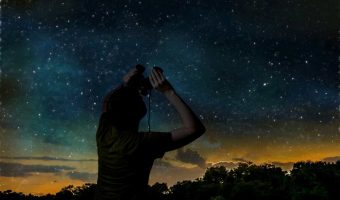
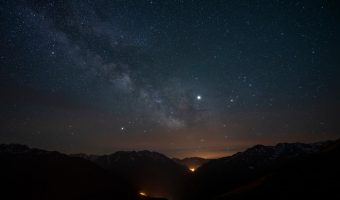
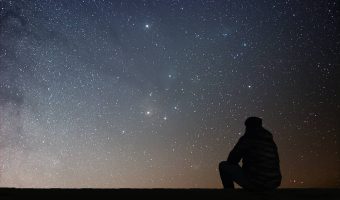
Planets are a popular observing target among amateur astronomers. Contrary to popular belief, telescopes are not always required to observe them.
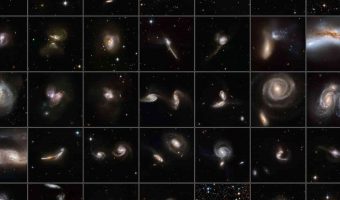
From nebulae to galaxies and beyond, this comprehensive list offers a wealth of celestial wonders to explore.
